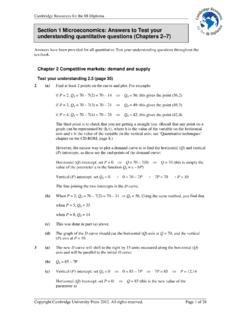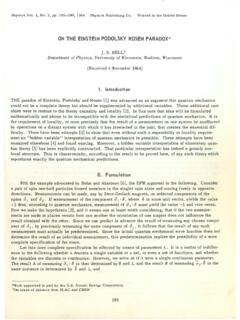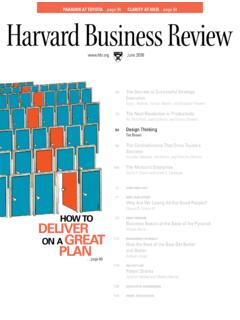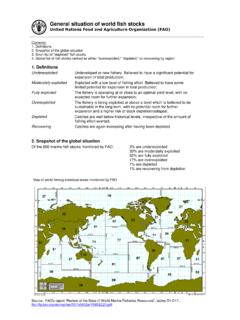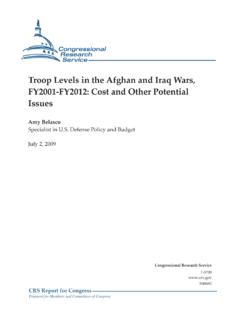Transcription of Theory of Knowledge for the IB Diploma: Student Notes
1 Theory of Knowledge for the IB diploma Theory of Knowledge for the IB diploma : Student Notes Introduction These Notes are designed to provide an easy-to-use summary of Theory of Knowledge for the IB. diploma by Richard van de Lagemaat. The Notes link to the other Theory of Knowledge for the IB diploma resources available on this website in order to provide a complete teaching resource for the course. Cross-references to the main textbook are given for every resource. Cambridge University Press 2011 Page 1 of 85. Theory of Knowledge for the IB diploma Understanding TOK mark schemes TOK assessment It is necessary to fully understand the marking criteria of TOK assessment if you understand the target, you can work towards providing the theoretical Knowledge and skills to reach it.
2 This section will therefore set out what has to be done to meet the IBO's marking criteria for Theory of Knowledge . Assessments 1 The TOK class presentation (20 points). 10 minutes (approx.) per Student + plan + summary in note form + teacher and Student justifications of assessment scores Group presentations are allowable: max. 5 students per group, but 2 3 seems to work best. 2 The TOK essay (40 points). 1200 1600 words chosen from a list of 10 titles issued annually by the IBO. Marks for TOK and the extended essay (EE) are combined for conversion into diploma points. The significance of TOK is thus apparent: TOK essay and EE score Points needed for IB. diploma E in both No diploma or do not submit one E in TOK or EE 28 points instead of 24. Out of 16 possible diploma -earning TOK and EE mark combinations: five ( ) only score 1 IB point three ( ) score 0 points.
3 That means there is a significant chance of not scoring many IB points as a result of TOK and EE. efforts. The necessity to know how to score points for TOK thus becomes obvious, especially if university entry depends on IB points scored. Cambridge University Press 2011 Page 2 of 85. Theory of Knowledge for the IB diploma TOK grade boundaries Note: These boundaries may change. A 48 60 marks B 38 47 marks C 29 37 marks D 19 28 marks E 0 18 marks diploma requirement goes up from 24 to 28 points (Source: IBO November 2009/May 2010 Subject Reports. Theory of Knowledge . Available on the teachers' area of the IBO. website.). Cambridge University Press 2011 Page 3 of 85. Theory of Knowledge for the IB diploma The TOK assessed presentation Requirements 10 minutes per presenter, max.
4 30 minutes per group (max. 5 students; 2 3 recommended). Every group must cover a different topic. Use supporting material, video, PowerPoint, posters, questionnaires, recordings, costumes, props, etc. Absolutely not to be an essay/ Notes read out. Suggestions: Give 4 8 weeks' notice and allow group work time in class. Plan for 3 practice presentations before the assessed presentation, 1 per term, year 1. Schools must record the presentations. Notified schools will need to submit recordings to the IB for review. All schools should keep the recordings until the session ends on the IB set date (mid- September for May exams or mid-March for November exams). Criteria for earning top TOK presentation points Assessment Maximum Marking hotspots'. criterion marks A Understanding 5 States a real-life situation which presents a Knowledge Knowledge issues issue(s).
5 A relevant Knowledge issue is identified. The Knowledge issue(s) is/are very relevant to the real-life situation considered. B Treatment of 5 Good' understanding of Knowledge issues (as opposed to Knowledge issues adequate' or some' understanding this is very subjective). C Knower's 5 Use of personal arguments. perspective Use of personal examples. Significance of the topic to the knower (personal involvement). is fully' demonstrated. D Connections 5 Clear presentation. Balanced view of different viewpoints/perspectives. Links between perspectives are recognised. Implications (in related areas) of different perspectives are recognised. Quality (not quantity) of connections between viewpoints is important in the marking. Cambridge University Press 2011 Page 4 of 85.
6 Theory of Knowledge for the IB diploma TOK question constructor Make choices in each column: 1 + 2 + 3 + 4. 1 Question 2 Subject 3 Action 4 Object (give a specific real-life example here!). To what extent emotion be used to a belief/decision/ethical issue? can explain/make/justify What is it about reason that tells us about sense/perception/truth/certainty/. culture/intuition/values/. How can sense perception be defined by interpretation/evidence/experience/. language explanation/technology? mathematics natural sciences human sciences history the arts ethics*. * Do not choose if 4 is ethical issue'. Red = way of knowing Blue = area of Knowledge What the TOK presentation consists of Plan: Form TK/PPD (Presentation planning document) on the back of form TK/PMF (Presentation marking form).
7 To be handed to the teacher (not the audience) beforehand. Plans how the presentation will progress in bullet form (see below). Brief introduction: Identify a real-life situation/contemporary problem. Identify personal involvement in the situation it is hard to separate hard facts from opinions, especially when our analytical viewpoint is biased by our own situation. Identify a Knowledge issue and explain why it is important to the real-life situation. Link to one (or more) identified Knowledge issues (these must be very relevant to the real-life situation). Cambridge University Press 2011 Page 5 of 85. Theory of Knowledge for the IB diploma Exploration (analysis): For the identified Knowledge area, analyse the identified Knowledge claims and link to different perspectives ( arising from areas of Knowledge , different ways of knowing, different theoretical approaches, different cultures).
8 The quality of the links is more important than the quantity. To do this: recognise the underlying assumption of each Knowledge claim/issue recognise the implications of different perspectives link to real examples recognise other Knowledge issues raised by the analysis include personal arguments and examples cite sources link all back to the original real-life situation. Timing of TOK presentation In view of the pressure on students in the last weeks of their IB courses, it is recommended that schools with a 3-term year should schedule presentations in term 4, with essays due at the start of term 5. Cambridge University Press 2011 Page 6 of 85. Theory of Knowledge for the IB diploma Student TOK presentation planner 1 Introduction planner Identify a real-life situation/contemporary problem: Identify your personal involvement in the situation and recognise that it is hard to separate hard facts from opinions, especially when our analytical viewpoint is biased by our own situation: Identify a Knowledge issue: Explain why the Knowledge issue is important to the real-life situation: Link to one or more identified Knowledge issues that are very relevant to the real-life situation: Cambridge University Press 2011 Page 7 of 85.
9 Theory of Knowledge for the IB diploma 2 Exploration (analysis) planner For the identified Knowledge area, analyse the identified Knowledge claims and link to different perspectives ( arising from areas of Knowledge , different ways of knowing, different theoretical approaches, different cultures). The quality of the links is more important than quantity. To do this for each Knowledge claim, plan your argument using the following table. Link all the Knowledge claim analyses back to the original real-life situation: Knowledge claim analysis planner Claim Underlying Different Implications Link to Other Personal assumption perspectives of different examples Knowledge arguments perspectives issues and raised by examples analysis Remember: Cite sources.
10 Cambridge University Press 2011 Page 8 of 85. Theory of Knowledge for the IB diploma The TOK assessed essay Electronic submission Details can be found on the IBO website in the document Theory of Knowledge : Understanding Knowledge Issues'. Students upload essays electronically to They log in using their six- character IB code plus a PIN issued by their school's IB Coordinator. The essay is then passed electronically to the teacher for marking and authentication. The IB Coordinator then submits it to the IB with their marks. The deadline is about three weeks after the deadline for essay upload. The IBO sends it electronically to an examiner for marking. Timing of TOK essay submission There is a two-month window' for submission. Specific dates are set by the IBO but it is approximately as follows: May exams: mid-January to mid-March submission of essay November exams: mid-July to mid-September submission.
